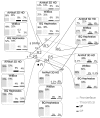Build Time Estimation for Fused Filament Fabrication via Average Printing Speed
- PMID: 31805643
- PMCID: PMC6926927
- DOI: 10.3390/ma12233982
Build Time Estimation for Fused Filament Fabrication via Average Printing Speed
Abstract
Build time is a key issue in additive manufacturing, but even nowadays, its accurate estimation is challenging. This work proposes a build time estimation method for fused filament fabrication (FFF) based on an average printing speed model. It captures the printer kinematics by fitting printing speed measurements for different interpolation segment lengths and changes of direction along the printing path. Unlike analytical approaches, printer users do not need to know the printer kinematics parameters such as maximum speed and acceleration or how the printer movement is programmed to obtain an accurate estimation. To build the proposed model, few measurements are needed. Two approaches are proposed: a fitting procedure via linear and power approximations, and a Coons patch. The procedure was applied to three desktop FFF printers, and different infill patterns and part shapes were tested. The proposed method provides a robust and accurate estimation with a maximum relative error below 8.5%.
Keywords: 3D printing; efficiency; experimental model; printing time; rapid prototyping.
Conflict of interest statement
The authors declare no conflict of interest.
Figures






References
-
- Gibson I., Rosen D., Stucker B. Additive Manufacturing Technologies: 3D Printing, Rapid Prototyping, and Direct Digital Manufacturing. Springer; New York, NY, USA: 2010.
-
- Bechthold L., Fischer V., Hainzlmaier A., Hugenroth D., Ivanova L., Kroth K., Römer B., Sikorska E., Sitzmann V. 3D Printing: A Qualitative Assessment of Applications, Recent Trends and the Technology’s Future Potential. Studien zum deutschen Innovationssystem; Belin, Germany: 2015.
-
- Shewbridge R., Hurst A., Kane S.K. Everyday Making: Identifying Future Uses for 3D Printing in the Home; Proceedings of the 2014 Conference on Designing Interactive Systems; Vancuver, BC, Canada. June 21–25 2014; pp. 815–824.
-
- Snyder T.J., Andrews M., Weislogel M., Moeck P., Stone-Sundberg J., Birkes D., Hoffert M.P., Lindeman A., Morrill J., Fercak O. 3D Systems’ Technology Overview and New Applications in Manufacturing, Engineering, Science, and Education. 3D Print. Addit. Manuf. 2014;1:169–176. doi: 10.1089/3dp.2014.1502. - DOI - PMC - PubMed
-
- Boparai K.S., Singh R., Singh H. Development of rapid tooling using fused deposition modeling: A review. Rapid Prototyp. J. 2016;22:281–299. doi: 10.1108/RPJ-04-2014-0048. - DOI
Grants and funding
LinkOut - more resources
Full Text Sources

